
Wetenschap
Zullen we ooit een zwart gat zien?
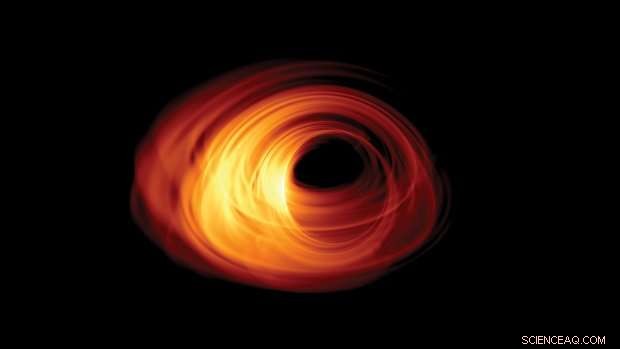
De schaduw van een zwart gat omgeven door een ring van vuur in een generieke simulatie. Krediet:T. Bronzwaer, M. Moscibrodzka, H. Falcke Radboud Universiteit
In de schaduwgebieden van zwarte gaten botsen twee fundamentele theorieën die onze wereld beschrijven. Zijn deze problemen op te lossen en bestaan zwarte gaten echt? Eerst, we moeten er misschien een zien en wetenschappers proberen precies dit te doen.
Van alle krachten in de natuurkunde is er één die we nog steeds niet helemaal begrijpen:zwaartekracht.
Zwaartekracht is waar fundamentele natuurkunde en astronomie elkaar ontmoeten, en waar de twee meest fundamentele theorieën die onze wereld beschrijven - de kwantumtheorie en Einsteins theorie van ruimtetijd en zwaartekracht (ook bekend als de algemene relativiteitstheorie) - frontaal botsen.
De twee theorieën zijn schijnbaar onverenigbaar. En voor het grootste deel is dit geen probleem. Ze leven allebei in verschillende werelden, waar de kwantumfysica de zeer kleine, en de algemene relativiteitstheorie beschrijft de allergrootste schalen.
Alleen als je op zeer kleine schaal en extreme zwaartekracht komt, botsen de twee theorieën, en op de een of andere manier, een van hen heeft het mis. In theorie althans.
Maar er is ooit een plek in het universum geweest waar we dit probleem in het echte leven konden zien optreden en misschien zelfs konden oplossen:de rand van een zwart gat. Hier, vinden we de meest extreme zwaartekracht. Er is maar één probleem:niemand heeft ooit een zwart gat 'gezien'.
Dus, wat is een zwart gat?
Stel je voor dat het hele drama van de fysieke wereld zich afspeelt in het theater van de ruimtetijd, maar de zwaartekracht is de enige 'kracht' die het theater waarin het speelt daadwerkelijk verandert.
De zwaartekracht regeert het universum, maar het is misschien niet eens een kracht in de traditionele zin. Einstein beschreef het als een gevolg van de vervorming van de ruimtetijd. En misschien past het gewoon niet in het standaardmodel van de deeltjesfysica.
Als een hele grote ster aan het einde van zijn leven explodeert, het binnenste deel zal bezwijken onder zijn eigen zwaartekracht, omdat er niet langer genoeg brandstof is om de druk tegen de zwaartekracht in te houden (ja, zwaartekracht voelt toch als een kracht, nietwaar!).
De zaak stort in en er is geen natuurkracht bekend die die ineenstorting kan stoppen, ooit.
In een oneindige tijd, de ster zal zijn ingestort tot een oneindig klein punt:een singulariteit - of om het een andere naam te geven, een zwart gat.
Natuurlijk, in een eindige tijd zal de stellaire kern zijn ingestort tot iets van een eindige grootte en dit zou nog steeds een enorme hoeveelheid massa zijn in een waanzinnig klein gebied en het wordt nog steeds een zwart gat genoemd!
Zwarte gaten zuigen niet alles om hen heen op
interessant, het is niet waar dat een zwart gat onvermijdelijk alles naar binnen trekt.
In feite, of je nu rond een ster draait of een zwart gat dat uit een ster is gevormd, het maakt niet uit, zolang de massa hetzelfde is. De goede oude middelpuntvliedende kracht en je impulsmoment houden je veilig en voorkomen dat je erin valt.
Alleen als je je gigantische raketmotoren afvuurt om je rotatie te remmen, begin je naar binnen te vallen.
Echter, als je eenmaal in de richting van een zwart gat valt, word je versneld naar steeds hogere snelheden, totdat je uiteindelijk de lichtsnelheid bereikt.
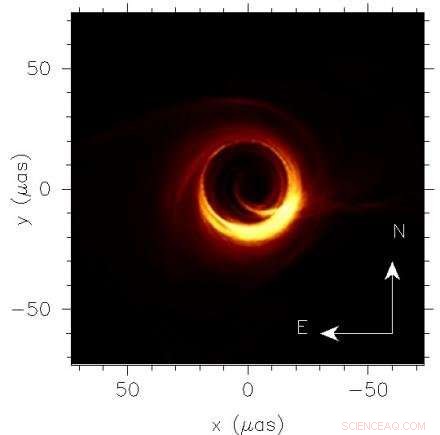
Gesimuleerde afbeelding zoals voorspeld voor het superzware zwart in het sterrenstelsel M87 op de frequenties waargenomen met de Event Horizon Telescope (230 GHz). Krediet:Moscibrodzka, Falcke, Shiokawa, Astronomie &Astrofysica, V. 586, P. 15, 2016, gereproduceerd met toestemming © ESO
Waarom zijn kwantumtheorie en algemene relativiteitstheorie onverenigbaar?
Op dit punt gaat alles mis als, volgens de algemene relativiteitstheorie, niets mag sneller gaan dan de snelheid van het licht.
Licht is het substraat dat in de kwantumwereld wordt gebruikt om krachten uit te wisselen en informatie te transporteren in de macrowereld. Licht bepaalt hoe snel je oorzaak en gevolg kunt verbinden.
Als je sneller gaat dan het licht, je kon gebeurtenissen zien en dingen veranderen voordat ze gebeuren. Dit heeft twee gevolgen:
- Op het punt waar je de lichtsnelheid bereikt terwijl je naar binnen valt, je zou ook met de snelheid van het licht moeten vliegen om aan dat punt te ontsnappen, wat onmogelijk lijkt. Vandaar, conventionele fysieke wijsheid zal je vertellen dat niets aan een zwart gat kan ontsnappen, als het eenmaal dat punt is gepasseerd, die we de 'gebeurtenishorizon' noemen.
- Het betekent ook dat plotseling de basisprincipes van het bewaren van kwantuminformatie op brute wijze worden geschonden - geconserveerde kwantumgrootheden kunnen eenvoudigweg achter een muur van stilte verdwijnen.
Of dat waar is en of en hoe de theorie van de zwaartekracht (of van de kwantumfysica) moet worden aangepast, is een kwestie van intens debat onder natuurkundigen, en niemand van ons kan zeggen in welke richting het argument uiteindelijk zal leiden.
Bestaan zwarte gaten eigenlijk wel?
Natuurlijk, al deze opwinding zou alleen maar gerechtvaardigd zijn, als zwarte gaten echt bestonden in dit universum. Dus, doen ze?
In de vorige eeuw zijn er sterke aanwijzingen dat bepaalde dubbelsterren met intense röntgenstraling in feite sterren zijn die zijn ingestort tot zwarte gaten.
Bovendien, in de centra van sterrenstelsels vinden we vaak bewijs voor enorme, donkere massaconcentraties. Dit kunnen superzware versies van zwarte gaten zijn, mogelijk gevormd door de samensmelting van vele sterren en gaswolken die in het centrum van een melkwegstelsel zijn gezonken.
Het bewijs is overtuigend, maar bijzaak. Zwaartekrachtgolven hebben ons in ieder geval het samensmelten van zwarte gaten laten 'horen', maar de signatuur van de gebeurtenishorizon is nog steeds ongrijpbaar en tot nu toe, we hebben nog nooit echt een zwart gat 'gezien' - ze zijn eenvoudigweg te klein en te ver weg en, in de meeste gevallen, Ja, zwart...
Dus, hoe ziet een zwart gat er eigenlijk uit?
Als je recht in een zwart gat zou kunnen kijken, zou je het donkerste donker zien, je kunt je voorstellen.
Maar, de directe omgeving van een zwart gat zou helder kunnen zijn als gassen naar binnen spiraalvormig zijn - vertraagd door de weerstand van magnetische velden die ze met zich meedragen.
Door de magnetische wrijving zal het gas opwarmen tot enorme temperaturen tot enkele tientallen miljarden graden en UV-licht en röntgenstraling gaan uitstralen.
Ultra-hete elektronen die in wisselwerking staan met het magnetische veld in het gas zullen intense radio-emissie gaan produceren. Dus, zwarte gaten kunnen gloeien en kunnen worden omgeven door een ring van vuur die op veel verschillende golflengten uitstraalt.
Een ring van vuur met een donkere, donker centrum
In hun centrum, echter, de waarnemingshorizon ligt nog steeds op de loer en als een roofvogel vangt hij elk foton dat te dichtbij komt.
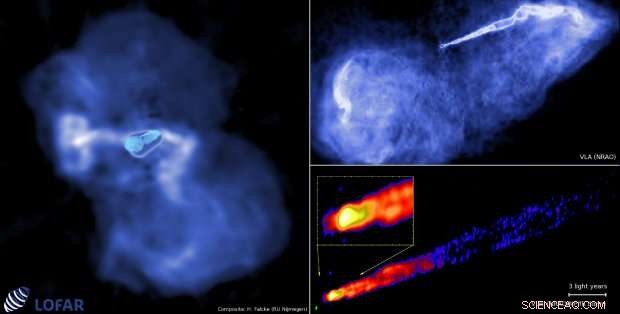
Radio images of the jet in the radio galaxy M87 – observed at lower resolution. The left frame is roughly 250, 000 light years across. Magnetic fields threading the supermassive black holes lead to the formation of a highly collimated jet that spits out hot plasma with speeds close to the speed of light . Credit:H. Falcke, Radboud university, with images from LOFAR/NRAO/MPIfR Bonn
Since space is bent by the enormous mass of a black hole, light paths will also be bent and even form into almost concentric circles around the black hole, like serpentines around a deep valley. This effect of circling light was calculated already in 1916 by the famous Mathematician David Hilbert only a few months after Albert Einstein finalised his theory of general relativity.
After orbiting the black hole multiple times, some of the light rays might escape while others will end up in the event horizon. Along this complicated light path, you can literally look into the black hole. The nothingness you see is the event horizon.
If you were to take a photo of a black hole, what you would see would be akin to a dark shadow in the middle of a glowing fog of light. Vandaar, we called this feature the shadow of a black hole .
interessant, the shadow appears larger than you might expect by simply taking the diameter of the event horizon. The reason is simply, that the black hole acts as a giant lens, amplifying itself.
Surrounding the shadow will be a thin 'photon ring' due to light circling the black hole almost forever. Further out, you would see more rings of light that arise from near the event horizon, but tend to be concentrated around the black hole shadow due to the lensing effect.
Fantasy or reality?
Is this pure fantasy that can only be simulated in a computer? Or can it actually be seen in practice? The answer is that it probably can.
There are two relatively nearby supermassive black holes in the universe which are so large and close, that their shadows could be resolved with modern technology.
These are the black holes in the center of our own Milky Way at a distance of 26, 000 lightyears with a mass of 4 million times the mass of the sun, and the black hole in the giant elliptical galaxy M87 (Messier 87) with a mass of 3 to 6 billion solar masses.
M87 is a thousand times further away, but also a thousand times more massive and a thousand times larger, so that both objects are expected to have roughly the same shadow diameter projected onto the sky.
Like seeing a grain of mustard in New York from Europe
Coincidentally, simple theories of radiation also predict that for both objects the emission generated near the event horizon would be emitted at the same radio frequencies of 230 GHz and above.
Most of us come across these frequencies only when we have to pass through a modern airport scanner but some black holes are continuously bathed in them.
The radiation has a very short wavelength of about one millimetre and is easily absorbed by water. For a telescope to observe cosmic millimetre waves it will therefore have to be placed high up, on a dry mountain, to avoid absorption of the radiation in the Earth's troposphere.
Effectively, you need a millimetre-wave telescope that can see an object the size of a mustard seed in New York from as far away as Nijmegen in the Netherlands. That is a telescope a thousand times sharper than the Hubble Space Telescope and for millimetre-waves this requires a telescope the size of the Atlantic Ocean or larger.
A virtual Earth-sized telescope
Gelukkig, we do not need to cover the Earth with a single radio dish, but we can build a virtual telescope with the same resolution by combining data from telescopes on different mountains across the Earth.
The technique is called Earth rotation synthesis and very long baseline interferometry (VLBI). The idea is old and has been tested for decades already, but it is only now possible at high radio frequencies.
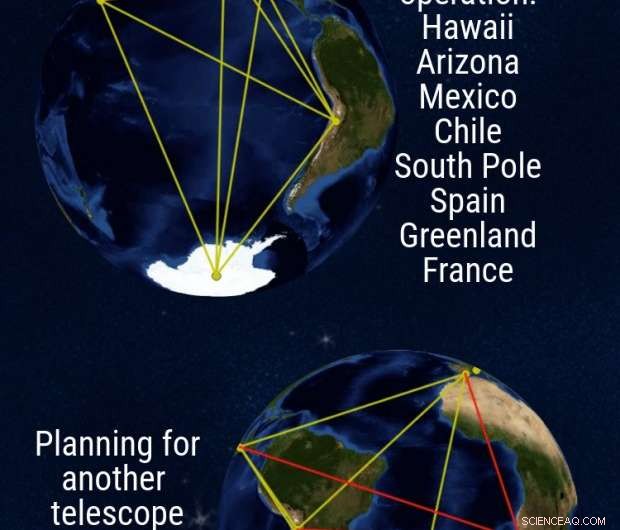
Layout of the Event Horizon Telescope connecting radio telescopes around the world (JCMT &SMA in Hawaii, AMTO in Arizona, LMT in Mexico, ALMA &APEX in Chile, SPT on the South Pole, IRAM 30m in Spain). The red lines are to a proposed telescope on the Gamsberg in Namibia that is still being planned. Credit:ScienceNordic / Forskerzonen. Compiled from images provided by the author
The first successful experiments have already shown that event horizon structures can be probed at these frequencies. Now high-bandwidth digital equipment and large telescopes are available to do this experiment on a large scale.
Work is already underway
I am one of the three Principal Investigators of the BlackHoleCam project. BlackHoleCam is an EU-funded project to finally image, measure and understand astrophysical black holes. Our European project is part of a global collaboration known as the Event Horizon Telescope consortium – a collaboration of over 200 scientists from Europe, the Americas, Asia, and Africa. Together we want to take the first picture of a black hole.
In April 2017 we observed the Galactic Center and M87 with eight telescopes on six different mountains in Spain, Arizona, Hawaii, Mexico, Chile, and the South Pole.
All telescopes were equipped with precise atomic clocks to accurately synchronise their data. We recorded multiple petabytes of raw data, thanks to surprisingly good weather conditions around the globe at the time.
We are all excited about working with this data. Natuurlijk, even in the best of all cases, the images will never look as pretty as the computer simulations. Maar, at least they will be real and whatever we see will be interesting in its own right.
To get even better images telescopes in Greenland and France are being added. Bovendien, we have started raising funds for additional telescopes in Africa and perhaps elsewhere and we are even thinking about telescopes in space.
A 'photo' of a black hole
If we actually succeed in seeing an event horizon, we will know that the problems we have in rhyming quantum theory and general relativity are not abstract problems, but are very real. And we can point to them in the very real shadowy regions of black holes in a clearly marked region of our universe.
This is perhaps also the place where these problems will eventually be solved.
We could do this by obtaining sharper images of the shadow, or maybe by tracing stars and pulsars as they orbit around black holes, through measuring spacetime ripples as black holes merge, or as is most likely, by using all of the techniques that we now have, samen, to probe black holes.
A once exotic concept is now a real working laboratory
As a student, I wondered what to study:particle physics or astrophysics? After reading many popular science articles, my impression was that particle physics had already reached its peak. This field had established an impressive standard model and was able to explain most of the forces and the particles governing our world.
Astronomy though, had just started to explore the depths of a fascinating universe. There was still a lot to be discovered. And I wanted to discover something.
Uiteindelijk, I chose astrophysics as I wanted to understand gravity. And since you find the most extreme gravity near black holes, I decided to stay as close to them as possible.
Vandaag, what used to be an exotic concept when I started my studies, promises to become a very real and very much visible physics laboratory in the not too distant future.
This story is republished courtesy of ScienceNordic, the trusted source for English-language science news from the Nordic countries. Lees hier het originele verhaal.
 De wereld duurzaam van brandstof voorzien:ammoniak synthetiseren met minder energie
De wereld duurzaam van brandstof voorzien:ammoniak synthetiseren met minder energie Gecontroleerde faagtherapie kan zich richten op medicijnresistente bacteriën en tegelijkertijd mogelijke onbedoelde gevolgen omzeilen
Gecontroleerde faagtherapie kan zich richten op medicijnresistente bacteriën en tegelijkertijd mogelijke onbedoelde gevolgen omzeilen Een groene katalysator voor farmaceutische en industriële chemie
Een groene katalysator voor farmaceutische en industriële chemie Domino-effect in farmaceutische synthese
Domino-effect in farmaceutische synthese Video:Hoe kimchi zijn kick krijgt
Video:Hoe kimchi zijn kick krijgt
 Hoe het verschil te zien tussen mannelijke en vrouwelijke kalkoenen
Hoe het verschil te zien tussen mannelijke en vrouwelijke kalkoenen Smeltende ijskappen zorgden voor zeespiegelstijging tot 18 meter
Smeltende ijskappen zorgden voor zeespiegelstijging tot 18 meter Op Kangaroo Island en elders, pas op voor de verleiding van de luxe ecotoerist
Op Kangaroo Island en elders, pas op voor de verleiding van de luxe ecotoerist Stedelijke geofoonarray biedt een nieuwe kijk op het noordelijke bekken van Los Angeles
Stedelijke geofoonarray biedt een nieuwe kijk op het noordelijke bekken van Los Angeles Diep magma vergemakkelijkt de beweging van tektonische platen
Diep magma vergemakkelijkt de beweging van tektonische platen
Hoofdlijnen
- Goud zeven uit de datastroom
- Wat zijn de functies van Triglyceride Phospholipid & Sterol?
- Veel vis in de zee? Niet noodzakelijk, zoals de geschiedenis laat zien
- Uit welke elementen bestaat glucose?
- nieuwe wegen, betere biobrandstoffen
- Dysmorfologie
- Hoop vervlogen voor gigantisch nieuw Antarctisch zeereservaat
- Waarom lijden 600 meisjes in Mexico aan collectieve hysterie?
- Landen in de Stille Oceaan kunnen door klimaatverandering 50 - 80% van de vis in lokale wateren verliezen
- Getijden kunnen een bron van warmte zijn op ijzige manen
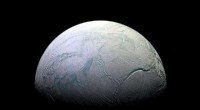
- Ruimtestation markeert 20 jaar mensen die in een baan om de aarde leven

- Video:Aeolus-time-lapse
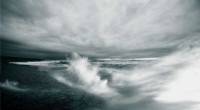
- Afrikaanse ruimtehavens verlagen brandstofkosten voor raketten

- China Hemeloog, 's werelds grootste single-schotel radiotelescoop, is nu volledig operationeel

 Concurrerende krachten lokken nanokubussen in spiraalvormige structuren
Concurrerende krachten lokken nanokubussen in spiraalvormige structuren The Common Snakes of Oklahoma
The Common Snakes of Oklahoma  Ingenieurs ontwikkelen nieuwe magnetische inkt om zelfherstellende apparaten te printen die in recordtijd genezen
Ingenieurs ontwikkelen nieuwe magnetische inkt om zelfherstellende apparaten te printen die in recordtijd genezen Moet voorschools schrijven meer communicatie zijn en minder ABC's?
Moet voorschools schrijven meer communicatie zijn en minder ABC's? Kijk uit, baai, de e-scooterrevolutie komt naar een stoep bij jou in de buurt
Kijk uit, baai, de e-scooterrevolutie komt naar een stoep bij jou in de buurt High-speed holografisch fluorescentiemicroscopiesysteem met submicron resolutie
High-speed holografisch fluorescentiemicroscopiesysteem met submicron resolutie Tijdelijk vormgeven aan het elektrische veld van een attoseconde puls
Tijdelijk vormgeven aan het elektrische veld van een attoseconde puls Fotonische communicatie komt tot computerchips
Fotonische communicatie komt tot computerchips
- Elektronica
- Biologie
- Zonsverduistering
- Wiskunde
- French | Italian | Spanish | Portuguese | Swedish | German | Dutch | Danish | Norway |

-
Wetenschap © https://nl.scienceaq.com

